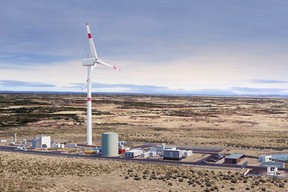Porsche is ready to mass-produce its synthetic 'green fuels'
Its Haru Oni facility in Chile has a target of 550 million litres of net-zero "eFuel" gasoline per year

Article content
Net-zero synthetic fuel is finally a reality. In a ceremony on September 10, Porsche opened its much-anticipated Haru Oni production facility in Punta Arenas, Chile . Wind-powered and retrieving carbon dioxide from the air, the plant is just the start of what Porsche sees as “large-scale of production for green fuels for the world.”
Advertisement
Article content
Porsche — and parent Volkswagen Group — are well-committed to an electric future, the luxury automaker continually expanding its EV portfolio. However, as the Michael Steiner points out, there are currently over a billion ICE-powered car operating globally.
“Despite all our enthusiasm for electric drives,” says the Porsche’s Executive Board Member for Research and Development, “it has been clear to us from the very beginning that electromobility cannot become the norm overnight.” Indeed, with more than 70 per cent of the sports cars — including its iconic 911 — it’s ever sold still in use today, there is plenty of incentive to prolong the life of internal combustion through the use of low-emissions fuel.
In its initial phase, Haru Oni will produce 130,000 litres of eFuels, which will be used primarily in its motorsports activities. In fact, according to Porsche the synth gas actually unleashes even more power from Porsche’s turbocharged race cars. Of course, there’s much more to eFuels that just racing and as production ramps up, Porsche and its partner Siemens hope to produce a whopping 550 million litres of net-zero gasoline per year, making it the “first fill” in all the internal combustion cars it produces.
Advertisement
Article content
Even that, according to Armin Schnettler, EVP New Energy Business, Siemens Energy, is only the beginning: “The hydrogen economy is the second step [after electrification] in reducing the world’s production of carbon dioxide.”
That’s because, in a process that sees hydrogen sourced from clean-energy electrolysis, the plant first produces methanol, which is then synthesized into gasoline with all the carbon “scrubbed” from the atmosphere, making internal combustion truly “net zero.” One of the important considerations in making the whole process completely green involves ensuring all the energy used in the process — the electrolysis of hydrogen is particularly energy-intensive — is harnessed from wind power. Indeed, the reason for the plant’s remote setting is that Punta Arena has the highest average wind speeds on the planet, Steiner saying that “the stormy southern chip of Chile the conditions is perfect for the production of synthetic fuel.”
Hurdles remain, not the least of which is how carbon-neutral synthetic gas will be treated by regulatory authorities. Will it be taxed the same as traditional gasoline, or will any added tariffs reflect its reduced emissions? Whatever the case, as Steiner says, ICE-powered vehicles will be with us for quite some time. Porsche and Siemens’ ground-breaking technology will lessen their impact on climate change.


